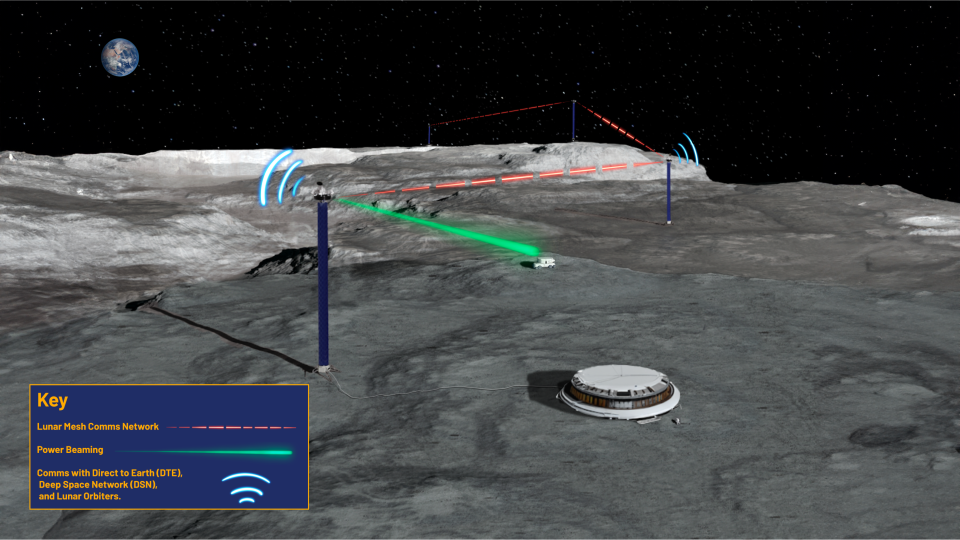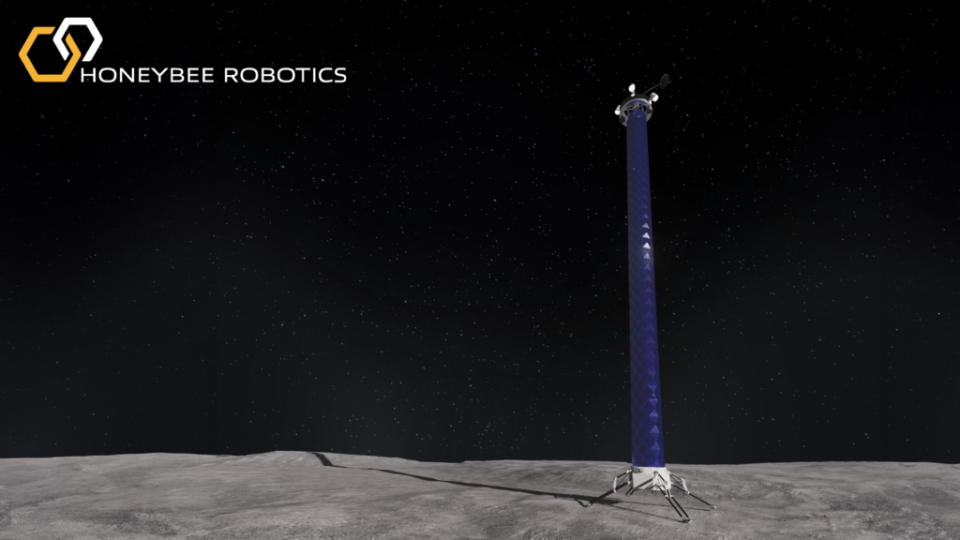A lighthouse on the moon; What a brilliant idea.
In long engineering jargon, this is called Lunar Assisted Navigation with Advanced Remote Sensing and Autonomous Beaming for Energy Redistribution, or LUNARSABER. The idea comes from Honeybee Robotics, a concept selected as part of the Defense Advanced Research Projects Agency’s 10-year Lunar Architecture (LunA-10) initiative.
This power tower will be approximately 330 feet (100 meters) tall and will be a deployable structure with solar panels on top, combining things like power storage and transmission, communications as well as location, navigation and timing, and even surveillance capacity under one roof. infrastructure.
Honeybee Robotics technologists predict that LUNARSABER can be scaled up to 650 feet (200 meters) above the lunar landscape to increase its service range. “LUNARSABER can be above the lunar horizon and always see the sun if we are at the south pole of the moon,” said Kris Zacny, vice president of Exploration Systems at Honeybee Robotics in Altadena, California. “We have cameras and communications systems right at the top of the structure. We have floodlights to illuminate the rovers’ areas,” Zacny told Space.com. “You put one or two of them at the south pole of the moon and you cover the whole area. That’s your lighthouse,” he said.
Relating to: The moon has been altered due to human activities. ‘Are we in the Lunar Anthropocene?’
Deployable structure
Vishnu Sanigepalli is Honeybee’s principal investigator at LUNARSABER on the DARPA LunA-10 study.
Sanigepalli said the moon’s poles are predicted to have endless peaks of light and the placement of solar panels will help generate energy year-round.
But after NASA’s Lunar Reconnaissance Orbiter (LRO) began mapping the moon, it was discovered that there was no place near the poles that received consistent sunlight year-round.
“In many analyzes using lunar topography, it has been discovered that the rims of craters near the South Pole have long lunar days due to their height, but not 100 percent,” Sanigepalli said.
Just being at the south pole of the moon doesn’t give you long lunar days. You also need to be on the highest mountain or crater feature.

Location and altitude
“If we have the ability to build really tall structures near the south poles, we can essentially ensure that there is more than 95 percent illumination throughout the lunar year,” Sanigepalli said. said. “It depends on the location And Height,” he emphasized.
It’s a great option because the crater rims are already elevated, Sanigepalli said. If structures even taller than 1,640 feet (500 meters) were built, they could support expansion to other regions and lunar deployment sites.
Helper solution
Sanigepalli said continuous illumination is not enough for lunar settlement. “We also need communication with Earth to keep lunar rovers, robotic systems and other equipment operational. So it becomes optimization of power and lighting for direct communication with Earth,” he said.
The firm believes LUNARSABER can enable lunar resource utilization as it is a highly adaptable service solution that will form the basis of a thriving lunar economy.
“We look forward to building partnerships with both commercial and non-commercial customers to host payloads and services that will help accelerate lunar infrastructure,” Sanigepalli said.


red water
While advancing lunar exploration ideas is at a premium in the near term, Honeybee Robotics is also developing RedWater, a mining system that aims to drill into the Martian surface and melt/extract water from certain Red Planet regions.
“This mining system will go tens of meters deep, penetrate underground ice, then melt and pump water to the surface,” Zacny said. “This is a robotic system that can do planetary mining and drilling,” he said, and can extract tens of tons of water from Mars’ underground ice deposits.
RedWater is another In-Situ Resource Utilization (ISRU) technology that enables and sustains human exploration of Mars by extracting water used for everything from life support and agriculture to fuel cells and propellant.
RAT and scoop
RELATED STORIES:
— DARPA-funded ‘Inchworm’ robots could help us build moon bases. Here’s how
— U.S. Space Force has new guidelines for operating on and around the moon
— Why is there so much military interest in the moon?
Honeybee Robotics is no stranger to designing, building, and deploying its hardware to other worlds. The innovative company provided the Rock Abrasion Vehicle (RAT) for use on NASA’s Spirit and Opportunity Mars rovers, which landed on the Red Planet in January 2004.
Their hardware was also deployed and demonstrated on NASA’s 2008 Mars Phoenix Lander mission. This Icy Soil Collection Device would have been better called “Phoenix Scoop”.
Other equipment provided by Honeybee Robotics is aboard NASA’s two currently active Mars rovers, Curiosity and Perseverance.
Japan’s Mars Lunar eXploration (MMX) mission, scheduled for send-off in 2026, is equipped with a P-sampler provided by Honeybee Robotics. This device is mounted along the leg of the MMX lander, which is designed to perform sampling operations after the Japanese probe lands on Phobos.
Creating mechanisms for extraterrestrial operations is a challenge, Zacny said: “But that’s part of the fun of building something from scratch. Otherwise, our lives would be boring if we had cookie-cutter robots.”